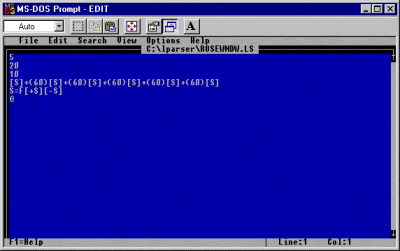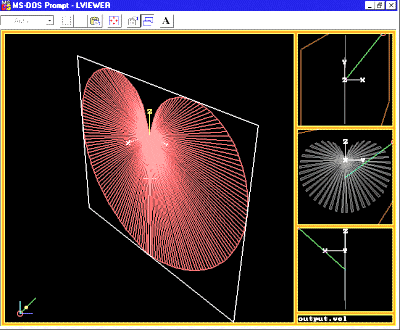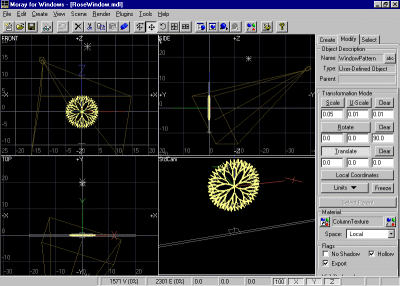Or, a quick and easy way to make something that looks like you know what you're doing.
 The creation of an image involving an L-System begins in the DOS text file editor, quite similar to Windows Notepad, which I am now writing this web page with. In this image,
the L-System code for the pattern in the Rose Window (see the gallery, page one) can be seen. This small code--5 lines long--produces the complex
pattern in the window. A modified version of this L-System was used for the Stained Glass window.
The creation of an image involving an L-System begins in the DOS text file editor, quite similar to Windows Notepad, which I am now writing this web page with. In this image,
the L-System code for the pattern in the Rose Window (see the gallery, page one) can be seen. This small code--5 lines long--produces the complex
pattern in the window. A modified version of this L-System was used for the Stained Glass window.
 After the L-System is created, I can get a rough wire-frame preview in LViewer (it comes with LParser - see L-Systems page). This program is probably used the most as I tweak
the L-System into doing what I want. This is an image of the lily pad used in the Water Lilies picture (see the gallery, page one).
After the L-System is created, I can get a rough wire-frame preview in LViewer (it comes with LParser - see L-Systems page). This program is probably used the most as I tweak
the L-System into doing what I want. This is an image of the lily pad used in the Water Lilies picture (see the gallery, page one).
 Here's a shot of 3DWinOGL (see L-Systems page). In this scene I'm previewing the flower from the Water Lilies picture.
This lets me see if anything's wrong with it before I save and use it. And, aside from actually rendering it, this is the only way I have to get an actual 3-D view of the object (non-wireframe).
Here's a shot of 3DWinOGL (see L-Systems page). In this scene I'm previewing the flower from the Water Lilies picture.
This lets me see if anything's wrong with it before I save and use it. And, aside from actually rendering it, this is the only way I have to get an actual 3-D view of the object (non-wireframe).
 ...And now I either render the object directly using POV-Ray, or here, edit it using Moray. Here's a shot of the Rose Window in the middle of construction.
I have the skeleton of the window highlighted, while the wall it's in (which can hardly be seen) is a flattened, elongated cube with a cylinder taking a circular slice out of it.
Where the cylinder makes the hole in the wall, the rose window pattern will be put into place. Now I just add a spotlight and some fog and I have a scene!
...And now I either render the object directly using POV-Ray, or here, edit it using Moray. Here's a shot of the Rose Window in the middle of construction.
I have the skeleton of the window highlighted, while the wall it's in (which can hardly be seen) is a flattened, elongated cube with a cylinder taking a circular slice out of it.
Where the cylinder makes the hole in the wall, the rose window pattern will be put into place. Now I just add a spotlight and some fog and I have a scene!
Of course, only a few of the images actually have an object in them created by an L-System... But that's it! Easy. |
